Latvia
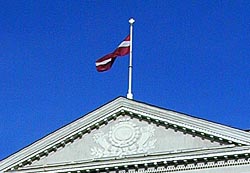
From having passed only briefly through the capitol
of Latvia in 1992, I got to spend a longer time there in 2002, and got to know the city and its inhabitants.
I also went on a very exciting excursion to the city Irbene, a closed military city in the Soviet
days, that did not exist. The sights that met me made my stomach flutter and filled me with dismay.
There and Back Again
|
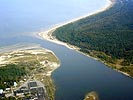 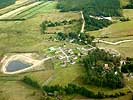 |
You fly from Sweden to Latvia in little propeller planes. The coffee is no good, but the view is fine. Here we
arrive over Latvia's coastline, flying over Ventspils en route to Riga Airport. |
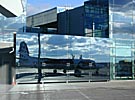 |
Riga Airport is fully modern, clad in glass. But it's not the kingdom of stainless steel, luckily. On the contrary,
all the furniture in the restaurant is hand carved in wood in traditional Latvian style. Nice to see. |
  |
Full of memories one returns back home to the salt mines. These pictures show the evening sun shining, gilding
the Latvian coast below me, just like in a painting. Riga is a beautiful city, and once the restoration is finished
and most traces of Communism are swept away, Riga, once the largest city of Sweden, will be just as nice as all
other European cities. |
Riga
|
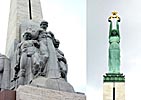 |
The first and most important thing to see in Riga is the freedom monument, the “Fatherland and Freedom”, a monument
that was actually erected in 1935, before the Soviet time, and couldn't be torn down because it was claimed that
it was built of donations from the people. It is a memorial and sign of honour to all those who were deported to
Siberia, fought and died for the country to be able to rise from enslavement, for the people to be allowed to speak
their own language, go to their own schools and learn about their own history. The close-up shows a group of figures
called “The Breakers of Chains”, those who freed the country from enslavement. On the top of the pillar stands
Goddess Milda with the tree stars, the symbols of the three regions Kurzeme, Vidzeme and Latgale. The goddess was
actually created by a Swede. |
 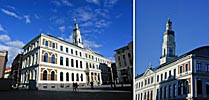 |
| The buildings are beautiful, yessir. Here are the ones a tourist will likely fall over first, near the Old Town,
the Stock Exchange on the square in front of the Riga Cathedral and a Swiss restaurant called the Alpenrose. The
last picture shows the City Hall on the square opposite the Blackhead's House. |
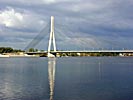 |
The Vanšu Bridge over Daugava River is famous for its, well, its looks, probably. A double pillar holding up the
bridge with carefully spaced wires. |
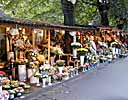 |
Street commerce is flowering (har-har) and the whole street smells delightful as one passes the flower shops. Latvia
has the same amber handicraft tradition as Lithuania, as the Baltic Sea continues to wash a lot of amber onto the
shores. It's also dug up in mines. The result is evident on the streets. |
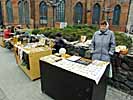 |
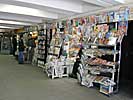 |
We took a turn through the Pirate Passage, under the railway station. It's a great selling place for magazines
and software, and not very much of it is genuine. But what to do for a poor country, when the companies just have
to be Microsoft Office compatible to be competitive with the West? The “Big Boy's” prices do not exactly excite
one into any comprehensive shopping spree. The Baltics have a sort of “kiosk economy” where most things can be
bought in kiosks, cheaper than in the shops. “Most things” also include computer software. |
  |
| Latvian food is rich and tasty (not as in ´92) for those inhabitants who can afford it, that is. We westerners
liked very much to visit Latvian style self-service establishments, like Lido's. At the same time we wished we
had some of the same in Stockholm. The Laima clock could also be included among the food items, a pillar used as
a popular meeting place at the entry to the Old Town. Laima is the goddess of happiness, and also the name of a
chain of goody shops across the Baltics. |
The Old Town
Like most other cultural cities, Riga has an Old Town, which in the case of Riga is from the 17th century, largely
built be the nasty Swedish invaders. The pictures below are but a microscopic panorama from a place where you could
linger for days and days. Note that most of the pictures have been “washed” of the overhead lines and hanging street
lamps for ever plaguing the most eastern European cities, thus taking some of the beauty away from the buildings.
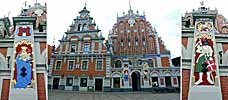 |
The most magnificent house in the Old Town is without doubt the House of the Blackheads, a house built in 1344
by German merchants. They needed somewhere to meet. Later, the house was left to decay, it was bombed during the
World Wars, and the Soviets weren't all that interested in restoring it. In the 21st century, free Latvia got to
grips with it and restored what was no more than a heap of rubble, into this masterpiece. |
|

|
The [gun] Powder Tower is part of the old fortification of Riga. It remains intact, perhaps because it is so sturdy
it won't fall apart just like that. |
  |
| This Old Town trek ends with a few facades that deserves to be shown, an Art Noveau style house, three beer-makers,
a very old facade that would benefit a lot from renovation, and finally a really juicy yellow facade set against
a bluer than blue sky. That's Swedish! |
Churches
Riga features a host of churches in various styles and I visited only very few of them. I'll have lots of beautiful
buildings left for the next time. I have no political or religious motives in choosing the pictures, I show only
what I think is beautiful or interesting.
The Riga Cathedral
|
|
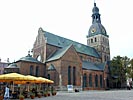
|
The Riga Cathedral is the beacon of the town, no doubt about that. |
  |
|
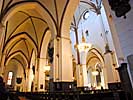
|
Inside, it is somehow bland, with not too many decorations, but he cage where they have the priest, is rather nice. |

|
|
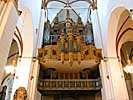
|
The organ is also nice, yes a true masterpiece, but unfortunately it was being restored while I was there. I might
go back again and make another picture when it is finished. |
|
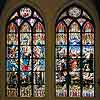
|
Stained glass is something I can't get enough of. |
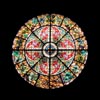
|
|

|
In an aisle outside the church I found two gravestones with relief, leaning against the wall. |
The Russian Orthodox Cathedral
|
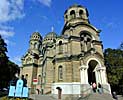 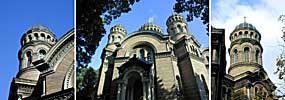 |
The Russian Orthodox Kristus Piedzimšanas Pareiztic Cathedral rises its gilded cupolas over the treetops in the
Esplanade Park at Brivibas Boulevard. To us westerners the se churches with their ancestry in the Byzantine era,
holds a special, mystic attraction, with their golden roofs and slanting crosses. One just has to get into them
and make pictures. As usual there are little old, bent ladies walking around all the splendour, polishing, and
putting fresh flowers in all the vases. Enter I, the typical tourist, waving my camera around, and immediately
I am apprehended by an old lady in kerchief, saying “Njet, njet, njet, sduygtuyehyftipborsjt” or something, meaning
that you can't take pictures in the church. “Da, da, da little lady” I think to myself and then I make my pictures
anyway, without flash. Why can't I show this masterpiece building to the rest of the world? Why should it be reserved
for old ladies in kerchiefs?
The church was built in 1876 and was turned into a planetarium in the Soviet era. Luckily for us, the practical
studies of the sky changed into more theoretical ones after 1991. |
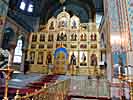 |
Gold, gold, gold, well gold leaf, but anyway. |
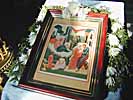 |
Nice picture. |
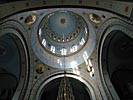 |
The inner roof is perhaps what impresses most. The divine light shines down from the cupola windows. You can see
it shining, can't you? |
 |
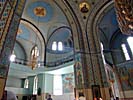 |
The rest of the interior is just as splendid, this is a rich church. Gold is gleaming from everywhere. |
I have visited a church much the same, The Uspenskij Chathedral in Helsinki.
Photo permission wasn't a problem there.
There is one thing worth pondering: all around outside the church are old lady believers, poor wretches in worn-out
clothes, begging for money from the passers-by. They don't look like they are having a very good life. 25 metres
behind their backs it's glistening of gold and icons of immeasurable worth. Somehow, this doesn't compute for me.
LatCon III – BaltCon 2002
LatCon III, the third SF convention in Latvia so far, was held at the end of September 2002. Sweden had a strong
representation, displaying four members. Other prominent countries were Lithuania with some seven members and Finland
showing another three.
 |
| The convention was held in the Riga Convention Centre. The square outside had glass pyramids, clearly inspired
by the pyramid at the Louvre in Paris. The foyer had a mummy with a wheezing breath. The fountain outside was interesting
in that its squirt-power changed all the time. One morning it turned even more interesting as someone had dumped
a package of washing powder in it. It livens up any fountain, and cleans it, too. |
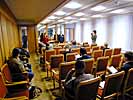 |
Gunta Dege and Kaspars Berzinš open the convention. There were few members, never more than 60, so they might change
the name to a minicon. The committee might spend more time thinking about advertising next year. |
 |
Gunta Vilka lectures on how the image of extra-terrestrials have changed because of the cinema. |
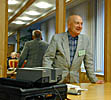 |
Lars-Olov Strandberg, the Swedish old-time fan does his historical slide show. Lars-Olov has been to conventions
since 1956 and has a large collection of slides, that the Latvians fans were now blessed with. The projector jammed
in a classical manner, and Ahrvid Engholm made the classical comments and pointing, and the big fans (“Look! That's
Harry Harrisson there!”) were smiling at us from the silver screen. |
 |
A stern lady who didn't smile unnecessarily. But she didn't have to. She got ovations anyway. Ieva Kolmane, who
was translating the Lord of the Rings, read us samples from her work and took questions about the adversities of
the translation (of which there are a few). After she had read the ring verse “One Ring to rule them all, One Ring
to find them, One Ring to bring them all and in the darkness bind them” there was a moment of silence and then
the ovations broke out. So, the Lord of the Rings is still being translated. Something to think about in Sweden
(which has one of the worst translations around), perhaps? |
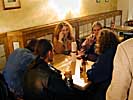 |
Late in the night of the first day, the Lithuanian delegation arrived from Kaunas. The brought a newly produced
fantasy film called “Anapus” (Beyond), 17 minutes in length, actually very professionally made, and exciting too. |
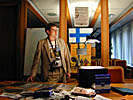 |
Pekka Sirkiä lectures on the problems with, and the development of Science Fiction and Fantasy literature
in Finland the last one hundred years, also touching on Finnish fandom. |
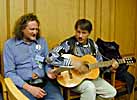 |
Ahrvid Engholm lectured on early Science Fiction in Sweden, from the mediaeval ages and onward, and the proceeded
to entertain us with improvised filksongs, together with Wolf von Witting. All the time Ahrvid maintained that
he didn't know the lyrics, neither could he sing, which we actually agreed on. |
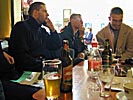 |
As lectures grew too heavy or our throats too thirsty, we took a tour to the cafeteria. They had beer, coffee,
beefs, pastries and E.T.s. Just what you need. Plus a wheezing mummy, which you don't really need. |
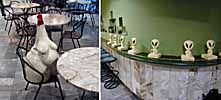 |
Some artists displayed SF inspired art in the cafeteria. The first one is a chubby, something like an erotic variety
of the Moomin Trolls. The yellow extra-terrestrials were called “Latvians”. |
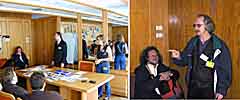 |
Gunta and Kaspars end off the convention on Sunday, and as you can see, Ahrvid gets a little emotional. Then it's
time for Imants Belogrivs to get emotional. He raises his J'accuse finger and tries to imprint in our minds how
important it is for Latvian fandom that we westerners visit the conventions, while jumping up and down in eagerness
to get this into our brain cells. We, on the other hand, sit and smile over the memories of all the fun we had. |
People
|
 |
Ahrvid Engholm, the chief protector of beer, won't give up until he has tried all the varieties, his sole intention
being establishing the qualities and types, and, as he is a great judge of beers he is soon able to deduce their
knock-out potential. |
 |
Andrius from Club Dorado in Vilnius fandom in Lithuania shows up and hugs Latvia's Mr. Science Fiction, Imants
Belogrivs, who has his own book publishing company. |
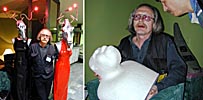 |
Imants takes a jab at the objects of art in the cafeteria. He has taken one of the objects and tries to convince
us all that we need to respect our forefathers, while Wolf von Witting does his best to convince him to put his
forefather back again. After some time he puts the bust aside, only to start cuddling with the extra-terrestrials
with snaking lamps in their heads. |
 |
| Later, on a pub in town, discussion is again heated, About what, we cannot disclose, or this web site would get
stuck in every family filter in the Internet. Again, Imants raises his J'accuse finger and demands that Wolf agree
with him. Wolf looks a bit embarrassed. After a few beers though, Imants' finger starts slacking, pointing downwards. |
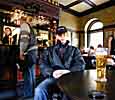 |
Toms Kriecbergs is an up-and-coming fan in Latvia. He was my personal guide the first day, and he is just radiating
with enthusiasm. That's the kind of people that fandom needs. |
 |
Wolf takes a long, loving look at his forefather. |
Irbene, near Ventspils
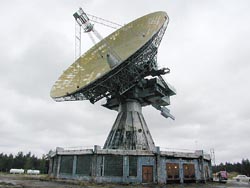
The convention committee had seduced us by promising a visit to an
ex-closed Soviet military city, having one of the largest radio telescopes in Europe, nowadays used for radio astronomical
research.
If you want to see something really unique, something you never thought existed, something post-apocalyptic,
then Irbene is the place. The tech-freak, as well as for someone seriously interested in radio and having a bent
for the extreme, should definitely plan to go to Irbene on your next holiday in the Baltics! If you are interested
in radio astronomy, you should be informed that there is no bigger and better antenna in all of northern Europe.
Irbene should be the Mecca of all serious radio-people, a place of pilgrimage for antenno-philiacs.
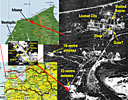 |
You won't find Irbene on any map, except for this one, which I have made myself. It is a zoom-in, starting a country
scale, going in all the way down to house-scale, with comments on objects. Google Maps shows Irbene here. |
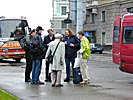 |
We got together in the early morning, some clear-eyed and awake, other with sleepy, grey faces and a strange headache
from yesterday (something wrong with the food?), for a three-hour journey into the unknown. |
The Looted City
|
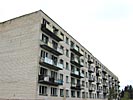 |
We arrive at the city that wasn't on the map. We get out of the car and just stand there, among derelict Soviet
residential blocks looking like they could fall down at any moment. Every window has been smashed. Suddenly I realise
the unheard-of thing we have just done: We drove straight through a military post, something that would have rendered
us full of little holes, had we tried it ten years ago. |
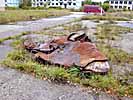 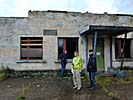 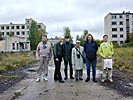 |
| The Irbene Spy Central had some 2000 people living here at its peak time, officers, wives and kids. The kids would
play in the forest around and the wives would... well... I don't know what they did, removed this far from absolutely
everything. The village is kind of thrown out in the wilderness, and there is only one house that might have been
a shop. As this village did not “exist”, they couldn't just go into Ventspils for a good night out. A sheet of
wrinkled metal on the ground is probably a piece of the roof blown down. We investigated a ripped-out house that
might have been the shop where people bought their bread. And vodka. What else could they do out here? We also
made a group photo to prove that were actually here. |
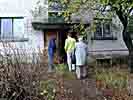
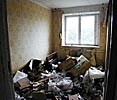 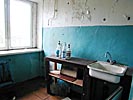  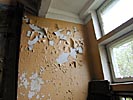 |
| We entered the first door we found in the after-the-catastrophe area and walked around in the devastated rooms.
Everything was smashed, stolen, dirty and derelict. Aha, a luxury kitchen - complete with bar. The only reason
the houses are still standing is probably that they could run them down with tanks. Still it sends a chill down
my spine, as the exact same kinds of houses are all around the former Soviet Union. I recognise every detail. There
was only one kind... After a few years of neglect the wallpaper starts coming off the walls and the paint starts
flaking. |
 * * 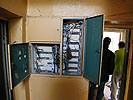 |
| A calendar left on the wall told us that this place was used as late as 1994, and when Ahrvid bent down and dug
around in the junk he suddenly pulled out an old, rotten gas mask. Of course. The ever-present, imaginary threat
of an invasion from the West, that was always looming over everyone. They were always prepared for the attack that
never came. When the Russians pulled out, they destroyed everything, broke it and behaved like... like Russians.
Each and every window is broken, the electricity meters are stolen, and they even took the water pipes. *Photo:
Pekka Sirkiä. |
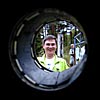 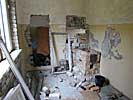 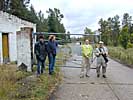 |
| On our way out of the village we again passed the military post, or what was left of it. The Soviet star had gone
rusty, and inside it looked like a dope den. I made a picture of Pekka Sirkiä through the gun port that the
guard probably used to shoot intruders through. We finish off with yet another group photo from this unbelievable
place. |
VIRAC – Ventspils International Radio Astronomical Centre
The Irbene antenna (The Radiolocator) was once part of the Soviet space programme. They needed to keep contact
with their spaceships wherever they were around the globe, and this was simply the western-most point of the Soviet
Empire. The also had ships equipped with antennae in the Atlantic and the Pacific Ocean to always stay in contact.
Well, the space program went down for counts, and the last years Irbene was mostly used for spying, listening in
on air traffic (military, one supposes) over Europe, and on telecom satellites. The phone calls would be de-scrambled,
taped, and sent to Moscow. The Soviet variety of Echelon. When the Russians withdrew, they strangely enough did
not blow up the antennae, but instead sold them to the Latvian research community, resulting in the formation of
the Ventspils Starptautiskais Radioastronomijas Centrs (Ventspils International Radio Astronomical Centre). From
the beginning there were three antennae, but only two, the 32-metre and the 16-metre, remain.
The 32-metre Antenna
|
 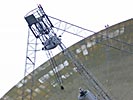  |
| The antenna is “Magnifique”, “Fanstatique” well, it's hard to find words to praise enough a 32-metre parabolic,
weighing some 600 tons, residing alone some 50 metres above ground on a concrete support that looks like it would
stand a hurricane. It stands, solely, in the middle of the forest, on the ever-leaning, Russian concrete slabs
that seems to have taken over every square and every other open place in the former Soviet Union, always slanting
off in random directions, with grass in between. As usual, a measure of the decay. |
  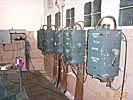 * * |
| The Control Room has an air of a 1940's film. The old, green control boxes and the round instruments look like
coming straight out of antiquity. They are not in use any more, as the researchers have thrown in a tremendous
amount of work computerising everything. Nowadays they only have to click on a star on a star map (on the computer
to the right in the first picture), for the antenna to swing there. The installations in the last picture shows
traces of home-brewing (the thin wires), necessary, as the Russians stole most of the cabling before they went.
*Photo: Pekka Sirkiä. |
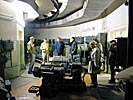 |
The Machine Room with its motors and elgons for feedback and control. It's not pretty, it's not modern, but fully
adequate to control this heavyweight to within a few milliradians of accuracy. There is not a thyristor in sight,
instead all control is executed through these rotating transformers. |
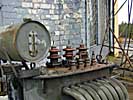
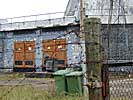 |
| In witness of a great bygone, when the area was guarded by the military and protected by seven perimeter fences.
Now, most of it is rusty. |
The 16-metre Antenna
|
 |
We went on to the 16-metre telescope, also very impressive. |
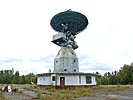 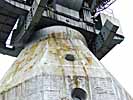  |
| These antennae are shipbuilding masterpieces, yes they are built on a shipyard. The traces are obvious, such as
the many round windows and many very heavily dimensioned parts. It is also obvious that it wasn't the same people
who built the gate. |
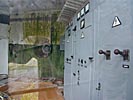
 * * |
| We couldn't get into the building, and had to stand outside, drooling. I shot a picture through one of the windows,
and got one power switching central and one wall covered in algae. Notice the roofing on top of the switch central
- indoors... The picture to the right shows me, doing some intrusive photography. *Photo: Pekka Sirkiä. |
 |
Our visit to the former secret city and spy central was at an end. We saw it fitting with yet another group picture.
There is a link to the radio astronomers in Irbene here. |
Conclusion – Outlook
I brought many exciting, funny and interesting memories back from Latvia. But my heart bleeds for all the wretched,
broken, poor old women sitting on the street corners of Riga day and night, trying to collect a few Lats from selling
flowers from a little metal bucket, or some small decorations that they made themselves. Why is it mostly old women?
What sort of life have they lived? Their husbands are probably long dead in the Second World War in the meaningless
fight for Stalin, and they are left alone to try to stretch their meagre pension begging. Is it possible to imagine
that these wrinkled wretches once were lively little girls with flying flaxen hair, running around the parks, laughing
and chattering, loved by their parents, not knowing about sadness? Sweet girls in light clothes, hoping for a happy
life. And what did they get from the Soviet Union? They got to starve and to regret, and they were given a shabby
hole to live in. Slandered for their poverty, they had to get used to chill, sorrow and wearing miserable, worn-out
clothes. They will probably end up as broken drunkards on the street, these poor who so looked forward to a bright
and happy life. Oh, the memories they might have...
Then, another picture overflows me. An old, white-haired grandmother sits on a park bench, cuddling a little
girl, a grandchild perhaps. The little girl is jumping on the park bench, and kissing her grandmother. Despite
everything, there may still be hope for the young and old in Latvia.


















 *
*